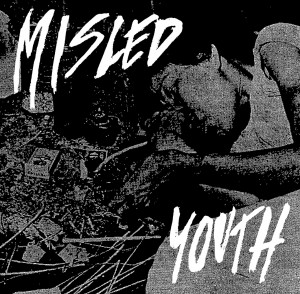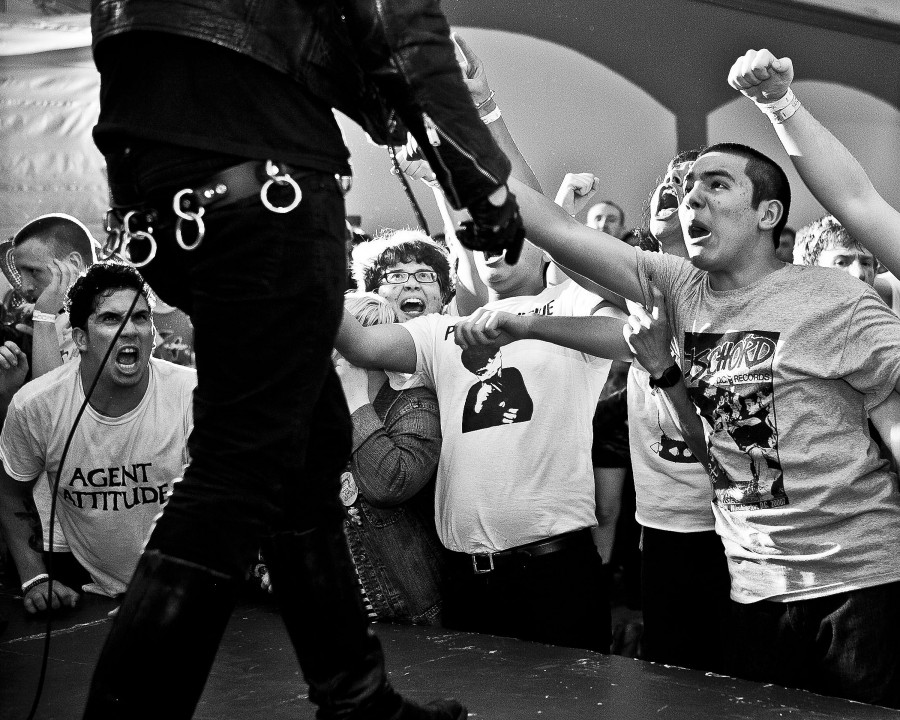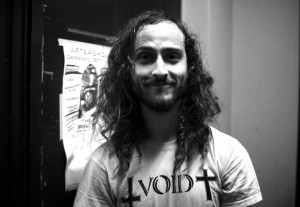It’s a Saturday afternoon, midway through an eight-hour-day of punk bands taking their turns on the stage at St. Stephen and the Incarnation Episcopal Church in Columbia Heights, and Cülo is about go to on. A Chicago group of self-described “mutants,” the punk band is an ideal fit for Damaged City Fest, a weekend-long hardcore-punk festival whose music ranges from heavy to heavier, fast to faster. But right now, Cülo is making Chris Moore nervous.
Moore, prolific punk-show promoter and drummer for D.C. hardcore band Coke Bust, is a key component in the engine that makes Damaged City go. He and bandmate Nick Candela booked the bands and the venue, and now here Moore is, in the packed chapel walkway that doubles as the festival’s marketplace, trying to make sure the whole thing stays on the rails. As fast as the band plays, Cülo has a reputation for slowing things down. So Moore heads back to the stage to make sure the band of mutants—and everything else—is keeping pace.
Damaged City is too important to go off course. The weekend-long all-ages festival, held two weekends ago primarily at St. Stephen’s and Columbia Heights dive The Pinch, is a celebration of hardcore in the city that birthed it and continues to embrace its ethics with more zeal than any other punk scene in the country. Alongside bigger headliners like Infest and Crudos, 10 D.C.-area hardcore bands played the fest, many of them part of a wave of surprisingly young musicians that their older peers say may be the greatest hope for D.C. hardcore in a generation.
But a dozen-odd bands doesn’t necessarily make a scene. What makes a scene are the few people who bring it all together. So there Moore stands, dutifully watching by the stage while Cülo sets up, sound-checks for maybe a tick too long, and rips into its set.
* * *
“Honestly, the best hardcore punk bands are kids between the ages of 13 and 19,” says Moore, a relative elder statesman at 27. “And there’s a ton of them. And they’re all [freaking] awesome. It’s crazy.”
Right now, D.C.’s hardcore scene has one of the most promising assortment of bands it’s seen in a long time, and many of their members are still in high school. The young Vile Faith put out an outstanding seven-song tape before disbanding last month, and some of its members—including drummer Robin Zeijlon—formed Pure Disgust and Public Suicide, the latter of which has its own EP coming out later this year. Nuclear Age released a blistering demo last fall. There’s Misled Youth, whose new album is already streaming online and should be released physically in a few months. Longer in the tooth are Red Death—whose January demo will probably go down as one of the year’s best D.C. hardcore recordings—the more metal Genocide Pact, straight-edge band Protester, and scene mainstays like Sick Fix, Give, and Moore’s own Coke Bust, among others.
Warning: Explicit lyrics.
In a way, the young kids have an advantage, because they’re more likely to live with their parents and they don’t bear the brunt of an increasingly unaffordable D.C. But those kids could also disappear from the area soon, as they go off to college or try their fortunes in another city. Moore—along with Candela—is part of the force that keeps the home fires burning.

Moore books and promotes dozens of local DIY shows a year. He hauls his PA from show to show. He stands outside of venues and hands out flyers. At Damaged City, he was the person running drum-kit components to and from the stage, depending on what the band needed. He also started a practice space behind his Takoma Park home that bands can use for as long as they need. “As far as I know, [it’s] the only affordable place you can just go and pay, like, $10 an hour and use a drum kit there,” says Priests drummer Daniele Yandel. “That’s so important for people who want to start bands.”
Moore tries to offers the kind of guidance he struggled to find when he first got involved in D.C. punk a decade ago.
Born in Montgomery County, Md., Moore was first introduced to punk rock around age 13. His mother was into ‘80s new wave and had punk friends from her days growing up in D.C. “That inadvertently exposed me to that stuff,” he says.
With his mom’s support, he started his first band in middle school, called Munk Petal, a spoonerism of “punk metal,” neither of which really described his band. Moore starts to characterize it in musical terms, then stops. “It’s what an eighth-grader’s first band would sound like,” he says.
Moore and his Munk Petal bandmates played their first show at his high school, just across the street from his family’s home. It went off as well as it could have, with his friends moshing in front of the stage. But midway through the set, the school’s security guards broke up the pit, saying it was too dangerous, and shut down the show.
Moore had an idea. He called home and moved the gig across the street to his mom’s basement. Over the next few years of high school, Moore says, he and his friends put on 30 or 40 shows in that basement, including performances by regional and national bands. “It started to become a regular spot for suburban Maryland kids to come to shows,” he says.
By 2005, Moore had already carved out space in the D.C. hardcore scene with his high school band, Magrudergrind, which started when Moore was 15 and went on to tour with bigger punk and metal bands across the country.
“I think it’s important to involve younger kids,” says Chris Moore. “It’s what makes D.C. special.”
But back at home, the scene wasn’t great, Moore says. When he first began booking gigs, there weren’t many active DIY venues, and music tastes were different: People were listening to screamo—which, for all of its punk influences, didn’t always adhere to the same value structure as hardcore. The older D.C. punk community had also wound down considerably, and by then “the majority of the older people in the area were [jerks], or I thought they were [jerks],” he says. “They were really alienating to younger kids.”
If that particular crew had been his only exposure to D.C. punk, he might have lost interest and dropped out, Moore says. But around the same time, he met Matt Moffatt and Pat Vogel from Crispus Attucks, a band that anchored the city’s hardcore scene at the time. They welcomed Moore and his teenage friends. Moore says they answered questions, got them gigs, and generally helped out however they could. That stuck with Moore. Ten years later, when kids ask for his advice or guidance, Moore does what he can to help. It’s his way of perpetuating an all-ages tradition that started with the days of harDCore and the early Dischord scene.
“I think it’s important to involve younger kids,” he says, whether it’s getting them shows or involving them in the process of booking shows themselves. “It’s what makes D.C. special.” Plus, he knows if he doesn’t help those kids—if he and folks his age are dismissive or cold—“the scene kind of dies with those older people.”
* * *
Just before Give takes the stage at St. Stephen’s, Ray Brown sits in the chapel’s pews, his elbows on his knees, and thinks about what hardcore in the city means to him.
“Community, definitely community,” he says. Brown is the 16-year-old bass player for The Black Sparks, another teenage group with as much potential as any in the scene. And he says the young bands are a big part of that community. Among them, he says, “in the past year there have been, like, 10 demos recorded.”
Brown appreciates the fact that his band’s relative success is made easier by D.C.’s hardcore tradition. “D.C.’s probably the only place where it’s almost impossible to go to a show at any age and be denied, like you can’t come in,” he says. “And that’s all because of Ian MacKaye, doing everything he did to make sure shows were all-ages.”
The resurgence of young, talented bands coursing through the scene is refreshing, says Tim Mullaney, singer and guitarist for D.C. death-metal band Genocide Pact. For years, he’s used his portable, door-to-door recording kit to tape demos for punk bands, including some of the young ones. Mullaney says there were some lean years earlier this decade, when all-ages spaces were in short supply and bands weren’t as numerous or active. But while it’s had its slumps, hardcore punk has never completely died here—and people like Moore help make sure it continues on for decades. “I don’t ever see those guys quitting booking shows,” Mullaney says. “There hasn’t been a year since I’ve started going to shows that Chris hasn’t been booking four or five big shows a year.”
Meanwhile, Mullaney sees new kids picking up the baton, like Robin Zeijlon, who books shows at Tenleytown restaurant Casa Fiesta and elsewhere.
The scene is in a different, healthier place than it was when he started out, Moore says. “I do think it’s important and it’s cool that this younger crop of D.C. punk bands is getting attention,” Moore says. Some of them are planning tours this summer, too—and that’s how the music and the message spreads.
“If I were a teenager, and I saw this ripping teenage band play my town, I’d think: Oh [man], I could do that. I want to do that.”
This article has been updated to emphasize the fact that Nick Candela also booked Damaged City Fest alongside Chris Moore.
Top photo: Cülo at Damaged City Fest. Image of Chris Moore courtesy of Chris Moore.




Pingback: Arts Roundup: Time Travel Edition - Arts Desk()
Pingback: District Line Daily: Michael Brown’s Prison Time - City Desk()
Pingback: Sem Hastro: D.C. Hardcore, Straight Out Of São Paulo | Ron Knox()